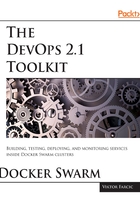
What does standalone Docker Swarm look like with service discovery?
Now that we have a better understanding of the requirements and the reasons behind the usage of service discovery, we can define the (real) flow of a request to a Docker Swarm manager.
Please note that we are still exploring how the old (standalone) Swarm is working:
- A user sends a request with the desired state to one of the Swarm managers.
- The Swarm manager gets the cluster information from the service registry, creates a set of tasks, and dispatches them to Swarm workers.
- Swarm workers translate the tasks into commands and send them to the local Docker Engine which, in turn, runs or stops containers.
- Swarm workers continuously monitor Docker events and update the service registry.
That way, information about the whole cluster is always up-to-date. The exception is when one of the managers or workers fails. Since managers are monitoring each other, the failure of a manager or a worker is considered a failure of the whole node. After all, without a worker, containers cannot be scheduled on that node:

Now that we established that service discovery is an essential tool for managing a cluster, the natural question is what happened to it in Swarm Mode (Docker 1.12)?